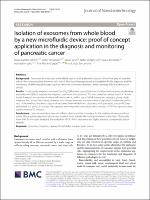Por favor, use este identificador para citar o enlazar este ítem:
https://repositorio.usj.es/handle/123456789/442
Registro completo de metadatos
| Campo DC | Valor | Lengua/Idioma |
|---|---|---|
| dc.contributor.author | Sancho-Albero, M. | - |
| dc.contributor.author | Sebastian, Victor | - |
| dc.contributor.author | Sesé, Javier | - |
| dc.contributor.author | Pazo-Cid, Roberto Antonio | - |
| dc.contributor.author | Mendoza, Gracia | - |
| dc.contributor.author | Arruebo, Manuel | - |
| dc.contributor.author | Martín-Duque, Pilar | - |
| dc.contributor.author | Santamaria, Jesus M. | - |
| dc.date.accessioned | 2021-02-08T14:10:40Z | - |
| dc.date.available | 2021-02-08T14:10:40Z | - |
| dc.date.issued | 2020-10-22 | - |
| dc.identifier.citation | Sancho-Albero, M., Sebastián, V., Sesé, J., Pazo-Cid, R., Mendoza, G., Arruebo, M., Martín-Duque, P., Santamaría, J., 2020. Isolation of exosomes from whole blood by a new microfluidic device: proof of concept application in the diagnosis and monitoring of pancreatic cancer. Journal of Nanobiotechnology 18.. doi:10.1186/s12951-020-00701-7 | es_ES |
| dc.identifier.issn | 1477-3155 | es_ES |
| dc.identifier.uri | https://repositorio.usj.es/handle/123456789/442 | - |
| dc.description.abstract | Background: Exosomes are endocytic-extracellular vesicles with a diameter around 100 nm that play an essential role on the communication between cells. In fact, they have been proposed as candidates for the diagnosis and the monitoring of different pathologies (such as Parkinson, Alzheimer, diabetes, cardiac damage, infection diseases or cancer). Results: In this study, magnetic nanoparticles (Fe3O4NPs) were successfully functionalized with an exosome-binding antibody (anti-CD9) to mediate the magnetic capture in a microdevice. This was carried out under flow in a 1.6 mm (outer diameter) microchannel whose wall was in contact with a set of NdFeB permanent magnets, giving a high magnetic field across the channel diameter that allowed exosome separation with a high yield. To show the usefulness of the method, the direct capture of exosomes from whole blood of patients with pancreatic cancer (PC) was performed, as a proof of concept. The captured exosomes were then subjected to analysis of CA19-9, a protein often used to monitor PC patients. Conclusions: Here, we describe a new microfluidic device and the procedure for the isolation of exosomes from whole blood, without any need of previous isolation steps, thereby facilitating translation to the clinic. The results show that, for the cases analyzed, the evaluation of CA19-9 in exosomes was highly sensitive, compared to serum samples. | es_ES |
| dc.format.extent | 15 p. | es_ES |
| dc.format.mimetype | application/pdf | es_ES |
| dc.language.iso | eng | es_ES |
| dc.publisher | Springer Nature | es_ES |
| dc.relation | This research was supported by the ERC Consolidator Grant program (ERC-2013-CoG-614715, NANOHEDONISM), the ERC Advanced Grant (ERC-2016-ADG-742684, CADENCE) and Instituto de Salud Carlos III (PI19/01007) and by Fondo Europeo de Desarrollo Regional (Feder) "Una manera de hacer Europa". We also thank CIBER-BBN, an initiative funded by the VI National R&D&i Plan 2008–2011 financed by the Instituto de Salud Carlos III with the assistance of the European Regional Development Fund. G.M. acknowledges the support from the Miguel Servet Program (MS19/00092; Instituto de Salud Carlos III). This study is also partially funded by the Aragon Government (T57_17R p) cofounded by Feder 2014–2020 "Building Europe from Aragon". Acknowledgements.We thank Roberta Manno and Dr. Miguel Urbiztondo for the 3D printing of the microdevice. We thank Pavel Strichovanec for his assistance in VSM measurements. We finally thank the LMA facilities for their continuous support and the Dr. Silvia Irusta for the XPS measurements. MS also acknowledge the Spanish Government for the receipt of an FPU predoctoral grant. | es_ES |
| dc.rights | Atribución 4.0 Internacional | * |
| dc.rights.uri | http://creativecommons.org/licenses/by/4.0/ | * |
| dc.subject | Exomas | es_ES |
| dc.subject | Captura magnética | es_ES |
| dc.subject | Microfuidos y cáncer de páncreas | es_ES |
| dc.title | Isolation of exosomes from whole blood by a new microfluidic device: proof of concept application in the diagnosis and monitoring of pancreatic cancer | es_ES |
| dc.type | info:eu-repo/semantics/article | es_ES |
| dc.subject.unesco | Cáncer | es_ES |
| dc.identifier.doi | 10.1186/s12951-020-00701-7 | es_ES |
| dc.rights.accessrights | info:eu-repo/semantics/openAccess | es_ES |
| Aparece en las colecciones: | Artículos de revistas | |
Ficheros en este ítem:
| Fichero | Descripción | Tamaño | Formato | |
|---|---|---|---|---|
| Insolation of exosomes from whole blood by a new microfluidic devide.pdf | 3,72 MB | Adobe PDF |  Visualizar/Abrir |
Este ítem está sujeto a una licencia Creative Commons Licencia Creative Commons

